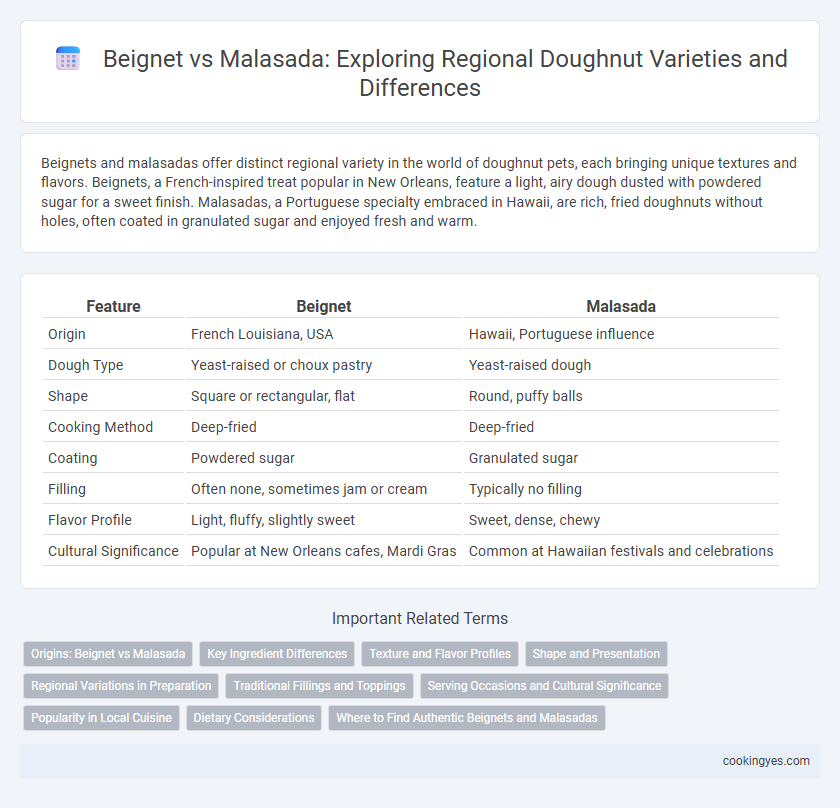Beignets and malasadas offer distinct regional variety in the world of doughnut pets, each bringing unique textures and flavors. Beignets, a French-inspired treat popular in New Orleans, feature a light, airy dough dusted with powdered sugar for a sweet finish. Malasadas, a Portuguese specialty embraced in Hawaii, are rich, fried doughnuts without holes, often coated in granulated sugar and enjoyed fresh and warm.
Table of Comparison
| Feature | Beignet | Malasada |
|---|---|---|
| Origin | French Louisiana, USA | Hawaii, Portuguese influence |
| Dough Type | Yeast-raised or choux pastry | Yeast-raised dough |
| Shape | Square or rectangular, flat | Round, puffy balls |
| Cooking Method | Deep-fried | Deep-fried |
| Coating | Powdered sugar | Granulated sugar |
| Filling | Often none, sometimes jam or cream | Typically no filling |
| Flavor Profile | Light, fluffy, slightly sweet | Sweet, dense, chewy |
| Cultural Significance | Popular at New Orleans cafes, Mardi Gras | Common at Hawaiian festivals and celebrations |
Origins: Beignet vs Malasada
Beignets originated in French cuisine, particularly from New Orleans, where they are deep-fried pastries dusted with powdered sugar, reflecting Creole cultural influences. Malasadas trace back to Portuguese settlers in Hawaii and are similar fried dough treats without holes, often coated in granulated sugar and sometimes filled. The distinct origins of beignets and malasadas highlight regional adaptations of fried dough in American and Hawaiian culinary traditions.
Key Ingredient Differences
Beignets, a staple of New Orleans cuisine, feature a key ingredient of yeast-leavened dough enriched with eggs and butter, resulting in a light, fluffy texture. In contrast, malasadas, popular in Hawaiian cuisine with Portuguese origins, rely on a dough enriched primarily with sugar and sometimes incorporate sweet fillings, yielding a denser, chewier bite. The distinct use of eggs and butter in beignets versus the sugar-forward, less enriched dough of malasadas highlights regional adaptations influencing flavor and texture profiles.
Texture and Flavor Profiles
Beignets offer a light, airy texture with a delicate crispness from being deep-fried and dusted with powdered sugar, delivering a mildly sweet flavor that complements their pillowy interior. In contrast, malasadas boast a denser, chewier consistency with a caramelized, golden crust and a richer, buttery taste often enhanced by fillings like custard or chocolate. Both doughnuts highlight regional preferences, with beignets rooted in New Orleans French cuisine and malasadas reflecting Portuguese influences in Hawaiian culinary tradition.
Shape and Presentation
Beignets are typically square or rectangular with a soft, pillowy texture and are generously dusted with powdered sugar, showcasing a light and airy presentation. Malasadas are round, golden-brown fried dough balls often coated with granulated sugar, offering a denser texture and a visually simpler, rustic appearance. Both pastries reflect their regional heritage through distinctive shapes and toppings that influence their sensory appeal and cultural identity.
Regional Variations in Preparation
Beignets, a signature New Orleans delicacy, are deep-fried pillows of yeast dough generously dusted with powdered sugar, reflecting French Creole influences. Malasadas originate from Portuguese Madeira Island and are popular in Hawaii, featuring a denser, fried dough often filled with custard or fruit jam and coated in granulated sugar. The differences in texture, filling, and sugar coating highlight distinct regional culinary adaptations of fried dough treats.
Traditional Fillings and Toppings
Beignets, a staple of New Orleans cuisine, are traditionally dusted with powdered sugar and often enjoyed plain or with fruit preserves as fillings, emphasizing a light and airy texture. Malasadas, originating from Portuguese and Hawaiian culture, are typically filled with custard, chocolate, or tropical fruit jams, and coated in granulated sugar, offering a richer and denser bite. Both regional doughnuts highlight distinct flavor profiles through their classic fillings and toppings, reflecting cultural preferences for sweetness and texture.
Serving Occasions and Cultural Significance
Beignets, popular in New Orleans, are traditionally served fresh at cafes during breakfast and festival celebrations, symbolizing French Creole heritage. Malasadas, originating from Portuguese cuisine and embraced in Hawaii, are commonly enjoyed as street food or desserts during local events and family gatherings, representing cultural adaptation and community bonding. Both doughnuts highlight regional identity through their serving occasions and deep-rooted cultural significance.
Popularity in Local Cuisine
Beignets are deeply rooted in New Orleans cuisine, often enjoyed as a classic French-inspired breakfast or dessert, known for their light, airy texture and powdered sugar coating. Malasadas, originating from Portuguese culture and widely popular in Hawaii, are celebrated for their rich, fried dough and variety of sweet fillings, making them a beloved local treat often found at festivals and bakeries. Both doughnuts highlight regional flavors, with beignets emphasizing delicate, fluffy bites and malasadas offering a denser, more indulgent experience favored in island cuisine.
Dietary Considerations
Beignets and malasadas differ regionally in their ingredients and preparation, affecting dietary considerations such as gluten and sugar content. Beignets, a staple of New Orleans cuisine, are typically made from wheat flour and deep-fried, leading to high gluten and calorie content. Malasadas, popular in Hawaiian cuisine, often use yeast for a lighter texture but still contain gluten and sugar, requiring those with dietary restrictions to consider alternatives or moderation.
Where to Find Authentic Beignets and Malasadas
Authentic beignets, a French-inspired doughnut, are best found in New Orleans, especially at iconic locations like Cafe du Monde, where their airy texture and powdered sugar topping remain a local staple. Malasadas, a Portuguese-style doughnut known for their crispy exterior and fluffy interior, are most authentically experienced in Hawaii, with Leonard's Bakery in Honolulu being a popular spot for their freshly made malasadas. Both treats offer distinct regional flavors and cultural heritage that highlight their unique origins and preparation methods.
Beignet vs Malasada for regional variety Infographic

 cookingyes.com
cookingyes.com